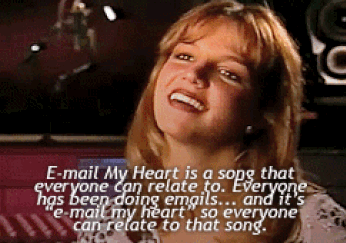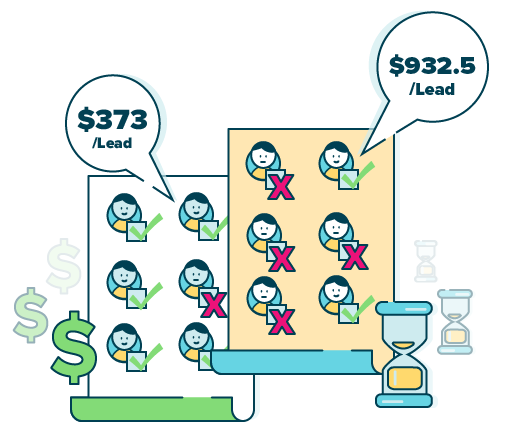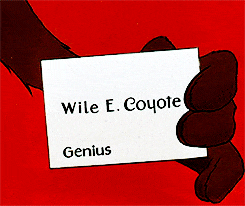Should You Buy Email Lists for Sales Leads?
Published: July 31, 2018Updated: July 24, 2024

Sales managers, what do you do when you’re desperate to fill your sales funnel? Here’s what to consider before buying a lead list, how to do it right, and alternative options for getting leads into your pipeline.
A solid email list is one of a business’ greatest assets. If someone gives you their email and a little bit more information about themselves, maybe by filling out a form on your website, you can be well on your way to turning that lead into a paying customer.
Though email lead generation and marketing has been around for some time now, it still ranks highly in terms of importance in these activities. What has changed is what consumers expect from businesses emailing them and how businesses are allowed to send emails. It’s currently easier than ever to get marked as a spam account, and the penalties now go beyond simply losing out on clicks.

When faced with a mandate to produce more leads and close more deals, the knee-jerk reaction for many sales and marketing teams is buying lists to cold email. That feeling of lead generation desperation can drive even the most level-headed marketer or sales rep to act in haste.
There’s more to buying email lists than simply sending out your messaging to those unsuspecting inboxes and waiting for the leads to come rolling back in.
A laundry list of downsides
Before you head out into the wilds of the internet in search of lead lists, take some time to consider the drawbacks, from costs and legalities to getting people to open the dang email.
Will you be able to wow your audience?
It’s generally considered not worth it to buy a big, bloated, ill-defined list. Sending a generic message to a huge list is a great way to get recipients to delete your email without reading.
In many cases, you won’t receive enough information about the lead to segment your email send and provide recipients with targeted information. Because these leads don’t know you, you’ll also need amazing first cold email subject lines and content to even get them to open the email and read it.
Can you afford it?
Even if you can get a cold email lead to read your message and they become a qualified lead, buying a lead list is not a cheap endeavor. You’ll have already put a lot of time and money into acquiring them.
And a so-called ‘cheap’ list can be costly. Brian Carroll, author of Lead Generation for the Complex Sale, says he experimented with a ‘cheap’ email list and an ‘expensive’ list for the same company’s lead generation project and compared final costs.
The cost per lead of the more expensive list was calculated at $373. The cost per lead for the cheaper list ended up being 2.5 times more. It took more time to qualify the leads on the cheap list, plus two-thirds were dud contacts who were no longer at those companies, so that meant additional time wasted removing them to clean up the list. Compare these numbers to this statistic: on average, a B2B lead costs $45 to generate online.

Is it illegal?
Though companies may have had success with buying email lead lists in the past, today it’s a great way to ruin your reputation with your email or internet service provider. For starters, the leads you buy might be old; with as fast as technology moves today, even a couple years old might be too out of date.
At best, the emails could bounce. At worst, you could be identified as a spammer. Many countries and regions, including Canada and the European Union (EU), have put privacy and other laws in place to target unwanted email spam.
The latest of these, General Data Protection Regulation (GDPR) in the EU and European Economic Area (EEA), became enforceable in May 2018. It outlines regulations for data protection and privacy for individuals in those regions.
GDPR also applies to any export of those individuals’ data outside of the regions. It’s designed to give citizens more control over their data and how it’s used. Penalties of up to 10 million Euros can be handed down to companies who do not comply.
Because of these laws, many email service providers won’t let users send to leads that they did not collect and receive opt-in consent from. And, some paid-for lists contain “spam traps.”
Spam traps look like valid email addresses but don’t belong to a real person. This means that these addresses are unable to give up-to-date opt-in consent and should not be receiving any unsolicited emails. Internet service providers (ISPs) use these addresses to identify email marketing fraud.
Pure spam traps are emails that never belonged to an actual person and were set up solely to catch spammers in the act. In other cases, long-dormant email addresses are used to find out which companies are not practicing responsible email marketing by scrubbing these old emails from their lists. For these emails, consent may have been given originally but the address was not removed from lists once it became inactive.
In all cases, the penalties for getting caught breaking anti-spam legislation can cost millions of dollars and torpedo the sender’s online reputation.

Maybe just say no
Do all these considerations seem like a lot to think about? That’s because buying a lead list—or even just emailing a list of contacts—has definitely gotten more complicated in the past couple years, with privacy laws, anti-spam legislation, and more.
There are lots of people out there who now say ‘just say no’ to buying lead lists, including Proposify’s own Kyle Racki.
It’s my party and I’ll email a list if I want to
If, after mulling over all those points, you decide that buying a lead list isn’t right for you, but you still want to splash out with a cold email lead generation campaign, there are a couple other ways to access contacts and lists.
In areas where it’s legal, some businesses task freelancers with creating a custom lead list by scouring the web or LinkedIn profiles. This can be helpful in putting together a lead list in a particular niche by specifying targeted job titles or companies. Thorough freelance list creators usually charge per hour to research, filter, and compile lists. If paying per lead, be very precise about the types of contacts you are looking for.
Another way to get your message in front of new email contacts is to partner with a non-competitor company with a similar target market to send a guest or sponsored message to their list. This sometimes requires special opt-in consent allowing third-party marketing, so tread carefully here, too. With a partnership like this, your business receives an introduction from a brand the leads already know and trust, and you can then invite them to opt-in to your list to receive more communication.
The fine print on these methods remains: no matter where the contacts are sourced, always make sure that all of your email communications are following applicable rules, regulations, and legislation, both in your region and where your recipients are located.
Refining your sales funnel
If you’ve ruled out buying, creating, or borrowing a list, what’s left? Let’s dig a little deeper into why you were considering buying a lead list in the first place.
What business goals were you trying to accomplish? Were there problems in your lead generation process you were trying to fix with an influx of new contacts? Why do you feel the need to pump a lot of leads into the top of your funnel?
It could be that the amount of leads currently going into the top of your sales funnel is perfectly fine. With some fine-tuning at other points in the funnel, it could provide you with all the qualified leads and sales you could want.
Here are some considerations to change your “feed the funnel” mindset to a “nurture and engage the funnel” one.
Get crystal clear on your ideal customer/buyer personas
Just as your ideal customer is not simply ‘anyone who visits the website,’ neither should it be ‘anyone with an email address.’ Are your lead generation activities too imprecise?
Before putting resources into any lead generation activity, you need to have a solid understanding of your buyer personas, the archetype of your target audience.
These buyer personas will inform all aspects of your business, including sales and marketing. Orienting your lead generation around these personas will keep your funnel filled with quality leads, ones more likely to close deals.
Enhance your qualification and lead nurturing process
Once you’re sure you’re attracting good quality leads, you can generate more revenue from them by engaging them.
To do this, make sure you’re enforcing strict criteria for qualifying your leads. For example, if you’re currently sending leads into the sales funnel simply because they reached out to you, and not because they fit with your ideal customer profile and buyer personas, that’s not enough to qualify them.
Though you might end up disqualifying more leads, doing this could free up time your sales team spends chasing dead-end leads to then apply to leads who are actually ready to buy from you.
Once they are qualified as leads, what information do they need to make their decisions? Approach the sales funnel from the buyers’ perspective and personalize the sales content and messaging to each segment or buyer persona.
Examine the “leads = revenue” way of thinking
“Total number of leads” coming into the funnel can be a vanity metric if they aren’t quality leads. You could be wasting time, energy, and other resources to get in front of people who are likely never going to buy from you.
This is where the cliché statements come in: you know, ‘less is more’ and ‘quality over quantity.’ They are classics for a reason. If you have your buyer personas and an efficient sales funnel, you should be able to pinpoint the amount of quality leads you need to optimize revenue. That way you’re not (one more cliché, sorry) throwing everything against the wall to see what sticks when it comes to lead generation.
Look at the bottom line
That feeling of lead generation desperation may have its roots in your company’s pricing structure. If your product or service offering is underpriced, your sales team needs to close more and more deals to make your quotas and revenue targets.
This means you need more and more leads coming into the top of the funnel. If you’re priced at the lower end of the spectrum, your sales strategy is going to be volume-based, instead of value-based.
If you have a tiered pricing structure, are too many of the leads coming in at the lowest tier? Ideally, your pricing structure should be set up with your top tier establishing a reference value. It should feel high, but not astronomic.
Your middle tier should be your sweet spot, pricing-wise, and should be where the majority of your customers end up. The lower tier is likely where you’re experiencing the bulk of your customer churn (leaving).
It’s a common sales adage that it takes far less resources to keep a current customer than acquire a new one. Placing a focus on customer retention and upselling could be more efficient than pushing to fill the top of your funnel with fresh leads.
Meet customers where they are in other ways
With the legislation mentioned above, companies can’t rely solely on email anymore. Everyone’s inboxes are filled to the brim and it’s hard to get messages in front of eyeballs, even if the recipients are open to receiving them.
Email is not the only game in town and hasn’t been for some time now. Where else are your potential customers found? What social media channels do they use? What does your presence there entail? Are your conversations two-sided or are you just pushing content and messaging out?
There are other opportunities for immediate conversations with leads. Do you have a live chat function on your website? Your support staff can triage messages and get the right information to leads right away. Even events and conferences, when approached correctly, can be treasure troves of new leads.

Re-energize the email lists you already have
Is your website optimized to create an email lead list for you? Collect emails from leads by offering subscriptions to free content or by locking valuable content behind forms.
If you’re already using email as part of your lead generation and mid-funnel strategies, putting resources toward getting the most out of the lists you already have could be more efficient than buying new contacts.
Evaluate whether you’re using your own email lists to their full potential. See how you could revitalize your strategy. Here, again, may be a case of quality over quantity.
Dig into the analytics—what subject lines are getting people to open your emails? What kinds of links are getting the bulk of the clicks? Are you running A/B testing to see what content works best with your audience?
How personalized are the emails? Are you segmenting your lists by buyer persona? Do you include the recipient’s name or dynamic content that changes what’s shown to them based on their interests or previous actions?
Email can be powerful when done right, and making your sends consistent and relevant is worth the time and effort.
Revisit your closed/lost deals
These leads are warmer than a random email list since they already know about your company and its offering. Perhaps they were a good fit but the deal didn’t close because of things beyond the sales rep’s control, like timing, budget constraints, or feature availability.
Have sales reps touch base with these leads to find out what’s new or changed since they last spoke, if there is a new way in which they can be helpful, and to simply stay top of mind. You never know when circumstances might change to make a sale feasible or the contact might move to a new role or company, putting them in a better situation for closing a deal with you.
Buying a sales lead list is fraught with complications and may or may not fit into your company’s lead generation activities. In any case, by taking a closer look at your reasoning behind buying an email list, you can fine-tune your entire sales funnel to engage more quality leads and close more deals.


